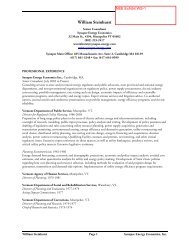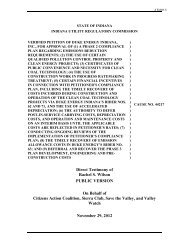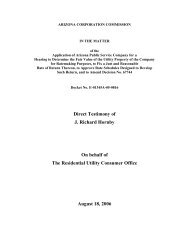Best Practices in Energy Efficiency Program Screening - Synapse ...
Best Practices in Energy Efficiency Program Screening - Synapse ...
Best Practices in Energy Efficiency Program Screening - Synapse ...
You also want an ePaper? Increase the reach of your titles
YUMPU automatically turns print PDFs into web optimized ePapers that Google loves.
<strong>in</strong>clusion of OPIs can sometimes make the difference between a program be<strong>in</strong>g costeffective<br />
or not.<br />
In theory, the different categories of OPIs should be <strong>in</strong>cluded <strong>in</strong> those tests where the<br />
relevant costs and benefits are applicable. In other words, the Societal Cost test should<br />
<strong>in</strong>clude the utility-, participant- and societal-perspective OPIs because this test accounts<br />
for the impacts from all these perspectives; the TRC test should <strong>in</strong>clude the utility- and<br />
participant-perspective OPIs because this test accounts for the impacts on utilities and<br />
participants; and the PAC test should <strong>in</strong>clude the utility-perspective OPIs because this<br />
test accounts for the impacts on utilities and customer revenue requirements.<br />
The primary rationale for <strong>in</strong>clud<strong>in</strong>g OPIs <strong>in</strong> the cost-effectiveness tests is to ensure that<br />
the tests are <strong>in</strong>ternally consistent. The whole premise of the tests is to assess the costs<br />
and benefits from different perspectives so that regulators and other stakeholders can<br />
consider the implications of the programs from those perspectives. If any one test<br />
<strong>in</strong>cludes some of the costs (or benefits) from one perspective, but excludes some of the<br />
costs (or benefits) from that same perspective, then the test results will be skewed, i.e.,<br />
they will not provide an accurate <strong>in</strong>dication of cost-effectiveness from that perspective.<br />
Test results that are skewed are mislead<strong>in</strong>g at best, and could lead program<br />
adm<strong>in</strong>istrators to significantly under-<strong>in</strong>vest or over-<strong>in</strong>vest <strong>in</strong> energy efficiency. In some<br />
cases, the test results could be skewed so much as to render them mean<strong>in</strong>gless.<br />
This is especially important <strong>in</strong> the application of the TRC test. 22 By def<strong>in</strong>ition, the TRC<br />
test <strong>in</strong>cludes the participant’s cost of the energy efficiency measure. In some cases, this<br />
cost can be quite large. In order for this test to be <strong>in</strong>ternally consistent, it must also<br />
<strong>in</strong>clude the participant benefits associated with the energy efficiency measure, <strong>in</strong>clud<strong>in</strong>g<br />
other program benefits. Exclud<strong>in</strong>g the participant-perspective OPIs from the TRC test<br />
will provide cost-effectiveness results that are skewed aga<strong>in</strong>st energy efficiency, will<br />
result <strong>in</strong> under-<strong>in</strong>vestment <strong>in</strong> energy efficiency programs, and will result <strong>in</strong> higher costs<br />
for all customers on average.<br />
Many regulators and other stakeholders are understandably concerned that <strong>in</strong>clud<strong>in</strong>g<br />
OPIs when screen<strong>in</strong>g energy efficiency programs is too comprehensive <strong>in</strong> that it <strong>in</strong>cludes<br />
costs and benefits that are outside of the regulators’ primary objectives. More<br />
specifically, many stakeholders are concerned that <strong>in</strong>clud<strong>in</strong>g other program benefits will<br />
require utility customers to pay <strong>in</strong>creased rates <strong>in</strong> order to achieve certa<strong>in</strong> benefits (e.g.,<br />
improved health, safety and comfort for participants) that should not be supported with<br />
ratepayer fund<strong>in</strong>g. This concern is understandable and is a critical consideration that<br />
should be made when decid<strong>in</strong>g which cost-effectiveness test to apply and how to apply<br />
it. We address this issue <strong>in</strong> Section 2.4.<br />
It is important to recognize that this issue of scope (i.e., whether to <strong>in</strong>clude impacts on<br />
participants) arises at the po<strong>in</strong>t when a commission (or legislature) decides on which test<br />
to use as the primary screen<strong>in</strong>g test. If the TRC test is chosen as the primary test, then<br />
the commission (or legislature) is mak<strong>in</strong>g an explicit or implicit decision to <strong>in</strong>clude costs<br />
to participants, which are typically outside the scope of regulators’ primary objectives <strong>in</strong><br />
the same way that other program benefits are outside that scope. Once this decision is<br />
made, the scope is established (i.e., impacts on both non-participants and participants);<br />
then it is necessary to determ<strong>in</strong>e how to ma<strong>in</strong>ta<strong>in</strong> <strong>in</strong>ternal consistency with<strong>in</strong> this scope.<br />
22<br />
This is also important for the Societal Cost test. Here we focus on the TRC test because of its<br />
widespread use.<br />
| 36 <strong>Best</strong> <strong>Practices</strong> <strong>in</strong> <strong>Energy</strong> <strong>Efficiency</strong> <strong>Program</strong> Screen<strong>in</strong>g | www.nhpci.org







